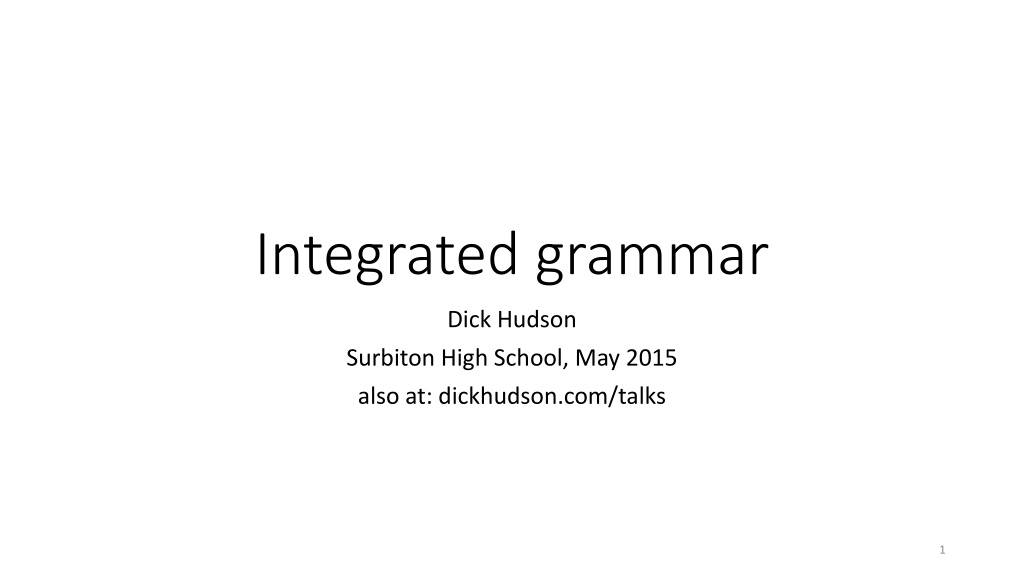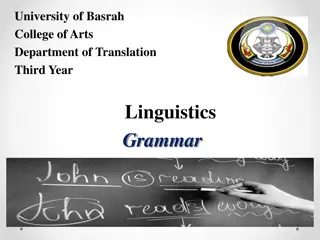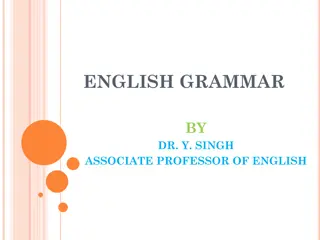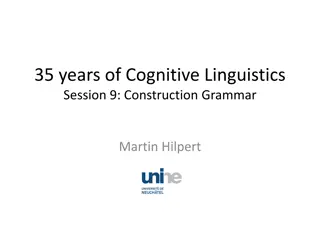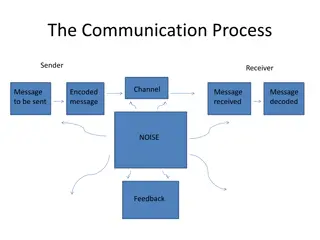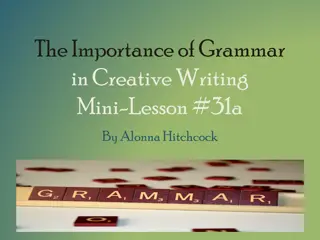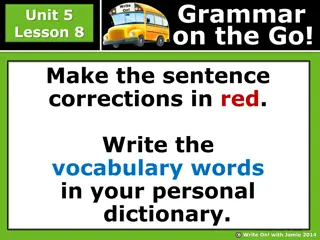Integrating Grammar for Effective Communication
Explore the integration of grammar concepts within various aspects of language learning, such as reading, writing, speaking, and listening. Understand the importance of utilizing grammar structures to enhance text comprehension and communication skills. Discover key elements of grammar, sentence structure, and text analysis through practical examples and expert insights.
Download Presentation

Please find below an Image/Link to download the presentation.
The content on the website is provided AS IS for your information and personal use only. It may not be sold, licensed, or shared on other websites without obtaining consent from the author.If you encounter any issues during the download, it is possible that the publisher has removed the file from their server.
You are allowed to download the files provided on this website for personal or commercial use, subject to the condition that they are used lawfully. All files are the property of their respective owners.
The content on the website is provided AS IS for your information and personal use only. It may not be sold, licensed, or shared on other websites without obtaining consent from the author.
E N D
Presentation Transcript
Integrated grammar Dick Hudson Surbiton High School, May 2015 also at: dickhudson.com/talks 1
Plan 1. Integrating grammar with KS2 2. Integrating grammar with texts 3. Integrating grammar with meaning: reference chains 4. Integrating grammar with writing 5. Integrating grammar with talking and listening 6. Integrating grammar with reading 7. Integrating grammar with FL 8. Integrating grammar with thinking skills 9. Conclusions 2
1. Integrating grammar with KS2: National Curriculum grammar terminology punctuation full stop question mark exclamation mark apostrophe comma bracket parenthesis dash ellipsis hyphen colon semi-colon bullet points inverted commas (or speech marks ) characters letter capital letter consonant, consonant letter vowel, vowel letter 3
KS2 Grammar words word noun adjective verb [morphology] compound suffix prefix word family [inflectional contrasts] [number] (singular, plural) tense (past, present) [meaning] ambiguity synonym antonym cohesion modal verb adverb preposition conjunction determiner pronoun possessive pronoun relative pronoun 4
KS2 Grammar sentences [clause structure] subject object adverbial [voice] active passive noun phrase direct speech sentence statement question exclamation command clause subordinate clause relative clause 5
2. Integrating grammar with texts Grammar is a tool for building texts. Grammatical analysis is a tool for understanding how texts work. But it needs to be used. Use it or lose it! Any text will do for practice. But some texts will also encourage grammatical growth. Many possibilities, including comparing: expert writing novice writing 6
199 words An expert: Orwell 7
The novice text 191 words Fix and forget! 9
How to use these texts Close grammatical analysis promotes noticing of grammar which arguably promotes understanding and confidence What has the novice achieved already? What grammar goes beyond ordinary conversation? What is the grammar gap ? What grammar does the expert use, but not the novice? What can they learn from the analysis to improve their reading writing? 10
start of defining subordinate clause sentence boundary Punctuation sentence Spot and correct punctuation errors in the novice writing. I carried on watching it moving along the water, I looked around to see if there was anybody near me, watching this strange creature, there was nobody. I looked around once more, there was silence [ ] the Loch Ness Monster had gone, Well, at least I thought it was the loch Ness Monster, maybe I just imagined it. I was sure I saw it though, but nobody will believe me, I stood there for a long time after, hoping that I would see the Monster again. Does every mark show a major syntactic boundary? Does every such boundary have a mark? What is the problem? 11
Punctuation and grammar Punctuation is a grammatical notation. So it reflects an awareness of grammatical structure. And it reflects conscious analysis. So novices need to become more conscious of grammatical structure more accurate in recognising distinctions. But of course this grammar relates to meaning e.g. defining/non-defining relative clauses. 12
3. Integrating grammar with meaning: reference chains A word has two kinds of meaning: its referent = the entity (person or thing) that it picks out on this occasion (e.g. Fido) its sense= the permanent meaning (e.g. dog ) which construes the referent. We invited our neighbourslast night. Mr and Mrs Smith were delightful, but the dogwas a nuisance. A reference chain (aka arc of coherence ) contains all the expressions (words or phrases) that refer to a particular entity. but the chain may include expression for other related entities. Building a successful reference chain requires grammatical expertise. 13
An expert reference chain for a place In the expert text, find the chain for the farm then all the related entities. Count the repeated expressions. 14
The farm Mr. Jones, of the Manor Farm, had locked the hen-houses for the night, but was too drunk to remember to shut the pop-holes. With the ring of light from his lantern dancing from side to side, he lurched across the yard, kicked off his boots at the back door, drew himself a last glass of beer from the barrel in the scullery, and made his way up to bed, where Mrs. Jones was already snoring. As soon as the light in the bedroom went out there was a stirring and a fluttering all through the farm buildings. Word had gone round during the day that old Major, the prize Middle White boar, had had a strange dream on the previous night and wished to communicate it to the other animals. It had been agreed that they should all meet in the big barn as soon as Mr. Jones was safely out of the way. Old Major (so he was always called, though the name under which he had been exhibited was Willingdon Beauty) was so highly regarded on the farm that everyone was quite ready to lose an hour's sleep in order to hear what he had to say. Repeated expressions = 0 15
A novice reference chain for a place In the novice text, find the chain for the loch then all the related entities. Count the repeated expressions. 16
The loch There I stood on the edge of the loch just looking around at the views and at the old castle which stood opposite me. Then from the middle of nowhere this monster like thing just popped out of the water, Its long green body moving slowly along the top of the water. Then I suddenly thought, is that the loch Ness monster ? I carried on watching it moving along the water, I looked around to see if there was anybody near me, watching this strange creature, there was nobody. I looked around once more, there was silence the Loch Ness Monster had gone, Well, at least I thought it was the loch Ness Monster, maybe I just imagined it. I was sure I saw it though, but nobody will believe me, I stood there for a long time after, hoping that I would see the Monster again. I saw the water ripple, I thought that I might see the Monster again, but no, It was Just the wind. Maybe there really is a Monster in that loch or maybe it was just my imagination. maybe I will see it again someday? Repeated expressions: the water x 4 17
How are the two chains different? The expert chain is richer in related entities. The novice chain has more repeated expressions. 18
Orwells people Find the chain for Mr Jones. Find any related entities. Find any expressions which construe him. 19
Orwell hardly construes Mr Jones at all because he s not important. An expert chain for a person Mr. Jones, of the Manor Farm, had locked the hen-houses for the night, but was too drunk to remember to shut the pop-holes. With the ring of light from his lantern dancing from side to side, #he lurched across the yard, kicked off his boots at the back door, drew himself a last glass of beer from the barrel in the scullery, and made #his way up to bed, where Mrs. Jones was already snoring. As soon as the light in the bedroom went out there was a stirring and a fluttering all through the farm buildings. Word had gone round during the day that old Major, the prize Middle White boar, had had a strange dream on the previous night and wished to communicate it to the other animals. It had been agreed that they should all meet in the big barn as soon as Mr. Jones was safely out of the way. Old Major (so he was always called, though the name under which he had been exhibited was Willingdon Beauty) was so highly regarded on the farm that everyone was quite ready to lose an hour's sleep in order to hear what he had to say. 20
Novices monster Find the chain for the monster. Find any related entities. Find any expressions which construe it. 21
Construal of the monster achieves little but causes problems. A novice chain for a monster There I stood on the edge of the loch just looking around at the views and at the old castle which stood opposite me. Then from the middle of nowhere this monster like thing just popped out of the water, Its long green body moving slowly along the top of the water. Then I suddenly thought, is that the loch Ness monster ? I carried on watching it moving along the water, I looked around to see if there was anybody near me, watching this strange creature, there was nobody. I looked around once more, there was silence the Loch Ness Monster had gone, Well, at least I thought is it was the loch Ness Monster, maybe I just imagined it. I was sure I saw it though, but nobody will believe me, I stood there for a long time after, hoping that I would see the Monster again. I saw the water ripple, I thought that I might see the Monster again, but no, It was Just the wind. Maybe there really is a Monster in that loch or maybe it was just my imagination. maybe I will see it again someday? 22
The grammar of reference chains Grammatical tools for defining referents: nouns and noun phrases (e.g. cats, a big cat, the cat) pronouns (e.g. he, him, himself, his) tenses and time adverbials (e.g. then ... looked) And ellipsis: complete omission. e.g. he lurched across the yard, _ kicked off his boots at the back door, _ drew himself a last glass of beer from the barrel in the scullery, and _ made his way up to bed, ... Also apposition = two juxtaposed nouns with the same referent e.g. old Major, the prize Middle White boar, 25
4. Integrating grammar with writing Grammatical analysis can improve writing (Myhill) for brighter children (because they learned most grammar?) provided that it s integrated immediately into a relevant writing task. What would be a relevant writing task for reference chains? Summarising the plot of a film or play Explaining the offside rule in football Giving instructions for assembling a piece of furniture Criteria for success: Every referent can be identified correctly and easily Senses construe entities by providing relevant information 26
5. Integrating grammar with talking and listening In pairs: A and B have identical piles of lego blocks. Neither can see the other s part of the table. A adds a piece and describes the change to B, so that B can do the same. Then it s B s turn to add a piece and so on till the pieces are used up. The winning pair is the first to build identical models. Success depends on effective reference chains! 27
6. Integrating grammar with reading See Animal Farm (cont). What do the colours mean? What is the general principle for finding the referent of a pronoun? Is there an exception? How do readers cope with it? How does Orwell distinguish characters introduced in pairs? Would pronouns do instead? What is the grammatical function of new characters? Do you have any advice about remembering numerous characters? 28
7. Integrating grammar with FL Grammatical gender in French: la table = feminine, e.g. Voici la table. Elle est ronde. le livre = masculine, e.g. Voici le livre. Il est bleu. Grammatical gender in English? no unlike the French, we have sex. but suppose we did have grammatical gender. Frenglish: she table, e.g. Here s she table. She is round. he book, e.g. Here s he book. He is blue. 29
Gender and reference chains Why do so many languages have grammatical gender? One benefit is in reference tracking: English: I bought a book and put it on the table, but it fell down. What fell down? The book or the table? Frenglish: I bought ahe book and put it on she table, but she fell down. 30
8. Integrating grammar with thinking skills Kiswahili agreement kitu kizuri good thing vitu vizuri good things mtoto mzuri good person watoto wazuri good persons mto mzuri good stream mito mizuri good streams 31
Welcome to the UK Linguistics Olympiad! Kitu kimoja kinaharibika. Vitu vimoja vinaharibika. Kitu kimoja kiliharibika. Vitu vimoja viliharibika. Ninaona kitu kimoja kilikioharibika. Ninaona vitu vimoja vilivioharibika. Ninaona kitu kimoja nilikiokiharibisha. Ninaona vitu vimoja nilivioviharibisha. Something breaks. Some things break. Something broke. Some things broke. I see something that broke. I see some things that broke. I see something that I broke. I see some things that I broke. kitabu kipya new book ?? new books break. ?? I break some new books that I saw. 32
9. Conclusions Grammar is a tool-box for building complex meanings. An expert s tool-box is biggerthan a novice s. An expert also understands the tool-box better and uses it more skilfully. Grammar teaching should promote growth, understanding and skill be integratedwith the pupils total experience of language education. 33
Thank you. Remember, this show is at dickhudson.com/talks. For the Linguistics Olympiad, see www.uklo.org 34
